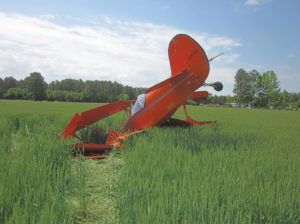Aviation is a numbers game. We fly the airplane by the numbers, we use numbers to navigate and we have to deal with numbers when we communicate. Airplanes have V speeds, cruise speeds, minimum speeds. We fly headings, course and bearings—all numbers. Maintenance is done at a specific number of hours, with fasteners torqued to specific values as shown in the manual.
So is it any wonder that when it comes to safety and accident prevention, we look to the numbers?

We have been collecting data (more numbers!) on aircraft accidents (“mishaps” is actually the preferred term) for generations. The data can be sifted, correlated, analyzed and shaped in many ways. We can tell what percentage of mishaps occur in each phase of flight, we can tell which types of aircraft are involved in particular scenarios and we can even figure out if more mishaps occur when the pilot was flying on an empty stomach.
We can crunch millions of numbers and present fancy charts and graphs to show just about any variation we want. And, frankly, that is part of the problem. All those numbers can be interpreted so many different ways that we—the collective “we,” meaning the aviation community—end up spending all of our time arguing about the meaning and relevance of the statistics.
Leave a Sample
How many times have you seen a presentation on the latest accident statistics head off on a tangent because someone is of the opinion that the sample size is too small or the years looked at were irrelevant? When was the last time you saw complete consensus on what constituted a valid sample of “experimental” aircraft? (I’m using quotes here because there are other categories beyond Experimental/Amateur-Built, and sometimes they get mixed up in the data.) How many times have you heard someone state that they simply didn’t believe that flying was more dangerous than the drive to the airport because they have personally had two auto accidents and never scratched an airplane?
Yes, we—pilots in general—are an argumentative bunch, and there is a lot to argue about when it comes to statistics. Quite frankly, I generally disregard statistical analysis unless I am looking for a very particular answer about a very particular problem; the broader the net (or database), the more general (and more useless) the answers it will offer.
I would argue, in fact, that statistics are a red herring when it comes to mishap prevention. They are a tool, one of many, to build a safety-enhancement program. But they are simply not sufficient to lower the mishap rate. Knowing how many mishaps are caused by specific things is useful and can be a basis for improvement. But when we never let ourselves get past the collection and interpretation of the data, we don’t do a darn thing toward preventing the next one.
In Search of the Why
What we need is not the what of accidents and mishaps; we need to get at the why. Knowing that 21% (or some number) of all reported mishaps occur when an aircraft departs the runway on landing is interesting, but doesn’t really help you figure out how not to do it yourself. Understanding the why of those runway departures is the first step in actually preventing the number from rising!
The first thing you learn in mishap investigation is to go after the whys of the event. Knowing what happened is interesting, but only as a stepping-stone. Very few pilots set out to have an accident on a given day. There may be the random few who decide that it is time to shear the gear off that old Cub or intentionally decide to fly through a mountain pass in a snowstorm just because they want to know what it’s like to hit a sheer cliff in the dark. (OK, maybe not that last one.) But let’s face it, those are the exceptions. By far, the majority of pilots would like to complete the flight and live to fly another day. The problem is, they frequently don’t bother to think about it. If they did think about it, and went back to look at stories of folks that managed to shear those gear off or run into that cliff face, it would probably help out a lot toward avoiding those same mistakes.
Knowing how many people did something that gave them a bad experience is less useful than knowing that some poor fellow ripped his gear off because he was attempting a slightly downwind landing with a large crosswind component, got a bad gust at the wrong time, ended up sliding sideways—and yet was doing alright until the gear went into the soft dirt on the side of the paved runway.
These are all links in what is known as the error chain. Break any link and you can oftentimes avoid the mishap altogether. Knowing the cause of a mishap is useful because then you can try and break the error chain in your own flying. You are aware enough to avoid the tailwind component, observe crosswind limits, make sure that if you’re going to go off the runway, do it straight ahead rather than slipping sideways and side-loading the gear—any one of those could have kept the airplane out of the statistical record.
While I find accident statistics an interesting topic of debate, I find mishap reports much more useful from an accident prevention standpoint. Putting myself in the cockpit with the pilot who made a mistake is a good way to learn where he or she went wrong. What were the warning signs? Is it possible to recognize them in my own flying? Is the cause of their mishap something new that I hadn’t heard of before? All of these questions can be answered by reading the reports—not just the statistics.
Read the Stories
The value of understanding the stories of previous accidents is not new: Almost every aviation magazine has a regular column or feature where pilots write about the events of a flight that did not go well. From military aviation journals to professional pilots’ trade-papers, these stories are ubiquitous not for entertainment but for education. They aren’t there to show how magnificent the author was in a time of stress—snatching survival from the jaws of certain death—but to share honestly what got him or her into that situation, as well as how good fortune (generally) got them out.
You don’t need to wait for the monthly magazine to arrive—go to the NTSB website and read the final reports from more accidents than you can count. Forget the broad categories; read the stories. See where the pilot went wrong. Occasionally—very rarely, actually—the airplane let the pilot down. But mostly it is the person at the controls who made a series of mistakes that lead to a bad ending. Figuring out how you would have broken that error chain is where the educational part comes in.
Of course, there is a lot to learn from reading, but applying the lessons is much more important. Stories of poor weather judgment need to be followed by some time in the sky, looking at (and dealing with) weather. Stories of poor aircraft handling (stalls and spins) should be followed by some time at the controls, remembering how the edge of the envelope really feels.
Forget the statistics. Look for the causes and learn from them. I really have no interest in the odds of my getting killed in an airplane versus in a car. I am a lousy gambler anyway and never paid much attention in statistics. All I know is that I have to do my best to learn the “why” of the accidents that do happen to prevent the numbers from growing.
So why is any of this important? As long as pilots keep arguing over the validity of the accident statistic, they avoid getting to the real meat of the subject: how to prevent additional mishaps by figuring out why they occur. In some respects, this might be a subtle, psychological thing. By avoiding getting to the real heart of the matter, pilots don’t have to address this unflattering conclusion: Most mishaps occur due to pilot error. If we can just keep arguing about the statistics, we don’t have to try and figure out what we (personally) are doing wrong. If we ever figure out what we’re (personally) doing wrong, we might have to then address that most dreaded of all words: change!
Admitting that we have to change is admitting that we were wrong in the first place—and the Type A personality that infuses the ranks of pilots tends to have a difficult time with that. Probably there’s a statistic for that, too.














Great article and insightful perspective.
Thanks for bringing the focus back to what we as pilots need to look at to be safer!
I have had that discussion many times. Friends killed in an airplane.
A good friend and I had this conversation about a year ago and we both agreed, despite the fact we both had MANY friends killed in an airplane.
Most of these friends were flying for fun or wages and there was no pressure to get the mission done, Non were in the military.
We both agreed this would not stop us from seeking the wild blue.
To be fair I tend to gravitate toward people who fly, but I cant think of a friend killed in a car.
That friend, the most meticulous, careful and pragmatic person I know was killed in his airplane just before Christmas. On a routine flight, one he had done probably hundreds of times before.
He was number 14 for me.
I’m still going to keep flying.
I’m sad for you Ray. But after 50 years , it is not my experience that many people I know have died in planes. In fact, if you don’t count gliders ( 2 friends have died in gliders ) then I don’t have anybody who died in a plane crash. They have all died from medical conditions.
If you look carefully at the statistics, I reckon you have been really unlucky.